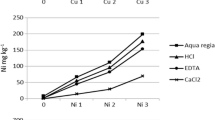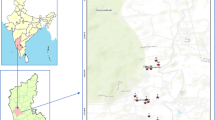Summary
Four out of six extractants were found to be promising for the prediction of critical level and response of barley grown in pots to copper application in young alluvium calcareous soils of Bihar (India). The critical level of available copper using DTPA-CaCl2 (pH 7.3), EDTA-(NH4)2CO3 (pH 8.6), NH4-oxalate and Mg (NO3)2, (pH 5.9) was 0.65, 0.82, 0.73 and 0.53 ppm, respectively. The relative extraction capacity of these extractants followed the order:
The amount of copper extracted by these extractants showed a significant and positive correlation with the concentration of Cu in plants, Cu-uptake, percentage yield and percentage uptake of Cu. Similar relation was found with clay and free CaCO3. They showed a significant negative correlation with soil pH. The amount of Cu extracted by DTPA-CaCl2 and EDTA-(NH4)2CO3 bore a significant positive correlation with organic carbon content of soils but the amount of Cu extracted by NH4-oxalate and Mg (NO3)2 was not significantly correlated with organic carbon content of soils.
Among all the four extractants, DTPA-CaCl2 was found to be the most and Mg (NO3)2 to be the least promising extractants in predicting variability of available Cu in soils. EDTA-(NH4)2CO3 proved to be better extractant than NH4-oxalate. The critical concentration of Cu in barley plant was 6.75 ppm below which responses to Cu application may be expected.
Similar content being viewed by others
References
Badhe N M, Nephade K T and Ballal D K 1980 Status of available copper of soils from Bhandera district in Marharastra. J. Indian Soc. Soil Sci. 198, 179–219.
Cate R B and Nelson L A 1965 Inter soil testing Technical Bulletine No. 1 North Carolina State Univ. Agricultural Experiment Station, Raleigh.
Cate R B and Nelson L A 1971 A simple statistical procedure for partititioning soil test correlation data into two classes. Soil Sci. Soc. Am. Proc. 35 1971.
Chatterjee R K and Rathore G S 1974 Plant available copper in Black soils of Madhya Pradesh. J. Indian Soc. Soil Sci 22(4), 383–385.
Change K L and Bray R N 1985 Two specific methods of determining copper in soil and plant material. Analysis Chemicals 25, 655–665.
Dolar S G and Keeney D R 1971 Availability of copper, zinc and managanese in soils. J. Sci. Fd. Agric. 22, 273–278.
Dwivedi K N and Shankar R 1977 Correlation of soil test with response to wheat to applied copper. J. Indian Soc. Soil Sci. 25, 410–413.
Fiskell J G A and Westgate P J 1955 Copper availability in high copper soils. Florida State Hort. Soc. Proc, 68, 192–197.
Grewal J S, Randhawa N S and Bhumbla D R 1969 Available micronutrients status of Punjab, Haryana and Himachal Pradesh. J. Indian Soc. Soil Sci. 17, 27–29.
Grewal J S, Chaman Lal and Randhawa N S 1969 Evaluation of available copper in soils of Ludhiana. Indian J. agric. Sic. 39, 877–885.
Griegg J L 1953 Determination of the available molybadenum of soils. New Zeal. J. Sci. and Tech. 34, 405–414 (c.f. 12th Annual Report on Micronutrient I.C.A.R. 1978–79).
Harmsen K 1977 Behaviour of heavy metals in soils. Agril. Research Reports 866. Centre for Agric. Publishing and Documentation. Wageningen (c.f. Soil Sci. 1982, 133(3) pp. 150–154).
Jackson M L 1967 Soil Chemical Analysis. Prentice Hall of India Pvt. Ltd., New Delhi Publication.
Lindsay S L and Norvell W A 1978 Development of a DTPA soil test for An, Fe, Mn and Cu. Soil Sci. Soc. Am. J. 42, 421–426.
Neelkantan V and Mehta B V 1981 Evaluation of methods measuring available copper in soils of khaira district of Gujrat. J. Indian Soc. Soil Sci. 29, 293–307.
Piper C S 1966 Soil and Plant analysis. Hans Publisher, Bombay.
Rai M M and Mishra M K 1967 Avalable copper in Madhya pradesh soils. J. Indian Soc. Soil Sci. 15, 18.
Rathore G S Gupta C P, Khamparia R S and Sinha S S 1978 Response of wheat of zinc application in alluvial soils of Morena district (Madhya Pradesh). J. Indian Soc. Soil Sci. 26, 59–62.
Sakal R, Singh A P, Singh B P and Sinha R B 1984 Evaluation of some chemical extractants for predicting response of wheat grown in pots to copper in sub-Himalyan soils. J. agric. Sci. Camb. 102, 659–666.
Tiwary R C and Bihamker B 1982 A suitable extraction for assessing plant available copper in different soils. Plant and Soil 68, 131–134.
Trieveweiler J F and Lindsay W L 1969 EDTA-ammonium carbonate soil test for zinc. Soil Sci. Soc. Am. Proc. 33, 49–53.
Author information
Authors and Affiliations
Rights and permissions
About this article
Cite this article
Singh, R.R., Prasad, B. & Sinha, H. Selection of suitable extractant for predicting the response of barley (Hordeum vulgare L) to copper application in calcareous soils. Plant Soil 93, 211–222 (1986). https://doi.org/10.1007/BF02374223
Received:
Revised:
Issue Date:
DOI: https://doi.org/10.1007/BF02374223




